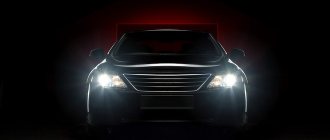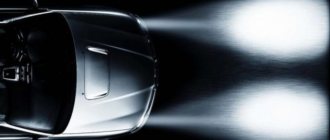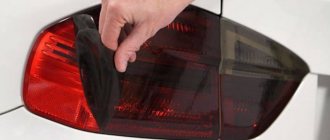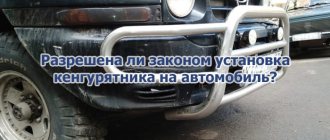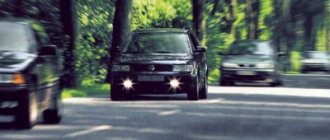Good afternoon, dear reader.
This article will review the rules of the road that apply to the use of vehicle headlights and lights in various driving situations.
Lighting devices are designed both to illuminate the road ahead of the car (to avoid collision with an obstacle) and to indicate the car itself (to avoid collision with other vehicles).
Unfortunately, many drivers do not know the rules for using headlights and flashlights, and therefore do not use all the opportunities provided to them.
- in good visibility;
- at night on an unlit road;
External car lights
At the beginning of this article, a few words about what external lighting devices a car may have. This information is primarily intended for those who are studying at a driving school and do not yet understand what these or other headlights or lanterns are intended for.
Note. The topic “lighting devices” is one of the most difficult in a driving school, because... It is difficult for a driver candidate who has never driven before to remember the similar names of light devices and the rules for their use.
parking lights
Dimensions are small light devices located approximately at the corners of the car (4 pieces in total). They do not shine very brightly and are primarily designed so that drivers of other cars can understand in the dark where your car begins and ends.
As a rule, the car is designed in such a way that when you turn on the low or high beam headlights, the dimensions turn on automatically. That is, low beam without side lights does not work.
Daytime Running Lights
DRLs are light devices in the front of the car (2 pieces), which shine quite brightly. They are designed to improve visibility of the car from the front during daylight hours.
Daytime running lights should not be used at night because... at night, they can blind oncoming drivers due to their high brightness. However, they do not illuminate the road.
In 2021, most cars are equipped with daytime running lights, but such lights are quite rare on cars manufactured before 2010.
Low and high beam headlights
Low beam (2 bulbs) and high beam (2 bulbs) headlights are the main lighting devices that are designed to illuminate the road in front of the car.
In this case, the low beam illuminates the area directly in front of the car, and the high beam illuminates a more distant area. It makes sense to use low beam at low speeds, high beam at higher speeds.
Fog lights
PTF - 2 headlights in the front bumper of a car, designed to illuminate the road in poor visibility conditions.
Fog lights are optional for 2021, so not all vehicle trim levels have them. That is, the car may not have PTF.
Fog light
Fog light - a red light at the rear of the vehicle, designed to improve visibility of the vehicle in poor visibility conditions. This light device is very bright and in good weather it can blind drivers of cars behind.
This lamp is required to be installed on all cars.
Is it possible to drive during the day with fog lights?
It has been proven that a car with its headlights on during the day becomes more visible to other road users. But can you use fog lights instead of daytime running lights? Let's turn to the traffic rules of the Russian Federation. Paragraph 19, which regulates the rules for the use of external lighting devices, states that during the day, low beam headlights or daytime running lights must be turned on on any vehicle. At the same time, the fourth subparagraph of the relevant rules allows the use of fog lights instead of low beam headlights during daylight hours. Thus, the use of fog lights during the daytime will not be a violation of traffic rules and will not entail a fine. But daytime running lights are designed in such a way that they consume less energy, which means that when using them, fuel consumption will be lower. It is worth separately noting that the use of side lights instead of daytime headlights is strictly prohibited and is regarded by traffic police inspectors as headlights not turned on.
There will be no fine for using PTF instead of DRL
Driving during daylight hours
In good visibility
When driving during daylight hours, the vehicle must have one of the following lights on:
- low beam;
- Daytime Running Lights;
- fog lights;
If the car has all the listed devices, then it makes sense to use DRL. These lights are brighter and use less electricity.
When driving, the following can also be turned on:
- parking lights.
It is prohibited to use:
- fog lamp.
In case of insufficient visibility
One of the following lighting fixtures must be used:
- low beam headlights;
- high beam headlights.
In this case, the main beam cannot be used:
- in populated areas on illuminated roads;
- when oncoming vehicles pass;
- when blinding drivers of passing or oncoming cars.
Additionally, the car may include:
- fog lights;
- fog lamp;
- parking lights;
- Daytime Running Lights.
Note. The rear fog light is specifically designed for use in conditions of poor visibility, but in practice no more than 10 percent of drivers use it. The rest, apparently, do not know the relevant rules.
Can fog lights be used during the day?
To find out the cases when it is allowed to activate fog lights, you need to refer to the traffic rules.
These situations are enshrined in clause 19.4. PTF can be included:
- in severe weather conditions that limit visibility on the roadway;
- on unlit roads at night;
- instead of low beams during daylight hours.
Based on this, we can give a clear answer: you can turn on fog lights instead of low beam headlights during the day. It is also worth noting that this paragraph of the traffic rules does not require turning on the fog lights, but allows for this possibility. On the other hand, there are no laws prohibiting the use of fog lights in other cases, and according to the principle of discretionary law: everything that is not prohibited is permitted. However, there are some conditions where using fog lights alone will not be enough.
When are fog lights not enough?
In some conditions, turning on only the fog lights will be a violation. Clause 19.4 states that in the dark and when there are problems with visibility, fog lights can be turned on with the main headlights. And when stopping in poor visibility, in addition to the headlights and PTF, you will have to turn on the side markers.
Driving in the dark
One of the following lighting fixtures must be used:
- low beam headlights;
- high beam headlights.
In this case, the main beam cannot be used:
- in populated areas on illuminated roads;
- when oncoming vehicles pass;
- when blinding drivers of passing or oncoming cars.
Additionally you can use:
- fog lights;
- fog lamp (only in case of poor visibility);
- parking lights.
What headlights should you turn on during the day?
According to clause 19.5 of the Russian Traffic Regulations, during daylight hours all cars must drive with low beam headlights or DRLs on. This is necessary so that when driving at high speeds, the motorist can notice an approaching vehicle in time and perform the necessary maneuver.
This rule is based on studies that have shown that drivers respond better to cars with running lights on. This rule helps reduce the number of accidents on high-speed highways.
Stopping and parking a car
At night on an unlit road
Must be included:
- parking lights.
It is prohibited to use:
- fog lamp.
Other lighting devices can be used.
In case of insufficient visibility (during dark or daylight)
Must be included:
- parking lights.
Other lights, including the rear fog lamp, may be used.
Let's go in circles
Deputy Chief State Road Safety Inspector Vladimir Kuzin explains to Rossiyskaya Gazeta all the nuances of the new edition of the Rules and amendments to the Administrative Code.
This book lists most of the changes to the Rules of the Road. But there are also those who remained in the shadows. You can't draw diagrams from them, but you have to travel along them.
Several new concepts have appeared in the Rules. For example, “daytime running lights”. They are installed on new European cars. Typically these are high-brightness LEDs that frame or highlight the headlight. If we were still required to drive on country roads with low beams on, now an exception has been added to the Rules: “or with daytime running lights on.” At the same time, owners of this equipment may no longer turn on the low beam headlights.
By the way, in the new edition of the Rules, low beams or these lights must be turned on when driving not only outside the city, but also in populated areas. That is, everywhere and always.
Particular attention should be paid to the point regarding the Rules for driving through roundabouts. When the Rules were first published, it was widely believed that traffic would change at all such intersections. If until now drivers used the rule of interference on the right, now those who move in a circle will have priority in roundabouts. This statement is not entirely true.
The Rules clearly state: if “give way” or “passage without stopping is prohibited” signs are installed on a roundabout, then in this situation vehicles located on the roundabout have priority. That is, those entering the intersection must give way to them. Moreover, the driver who has entered the circle will already know for sure that he has the advantage in traffic.
By the way, the practice of using such a system has shown that the intersection is quickly cleared, and its capacity increases accordingly.
If such signs are not installed, then the “interference on the right” rule is still in effect at this intersection. And here those who are moving in a circle must give way to those who are entering the intersection. There is a need to organize the movement in this way.
It must be said that the current wording of this paragraph of the rules is fully consistent with the International Convention on Road Traffic. That is, it fully complies with Western requirements.
At first, I would recommend that drivers carefully look not only at the signs in front of the circle, but also at the behavior of other road users. It is clear that not everyone will know them immediately after the amendments to the Road Traffic Rules come into force. In addition, we have a developed tradition of driving not according to rules and signs, but out of habit and memory. Be careful on the roads.
All diagrams depict “ideal” cases. In this case, the circumstances of the commission of a particular violation are not taken into account. In practice, these circumstances are often important for qualifying a violation. Therefore, if your case is not ideal, and the inspector has classified it under a different article than in the proposed schemes, then you will have to deal with it in court.
Address of the Road Safety Department of the Ministry of Internal Affairs of Russia: 101000, Moscow, st. Myasnitskaya, 3.
The materials were prepared by Vladimir Barshev. All infographics in the “Useful Book” are made: “Infographics “RG” / Leonid Kuleshov / Vladimir Barshev.
What do the traffic rules say, are there any changes since June 6?
And the traffic rules still unambiguously and unconditionally establish in clause 19.5 that during daylight hours, drivers of any moving vehicles are required to use running lights or use low beam headlights to indicate their vehicle.
Below is a paragraph of the rules without distortion.
This means that you are required to drive with low beams or running lights at any time of the year during daylight hours, if the latter are provided for by the design of your car.
Alternatively, drivers can use fog lights in combination with low beam and running lights. Just don’t confuse the classic “dimensions” with running lights.
But where did the rumor about the abolition of low beam headlights come from?
